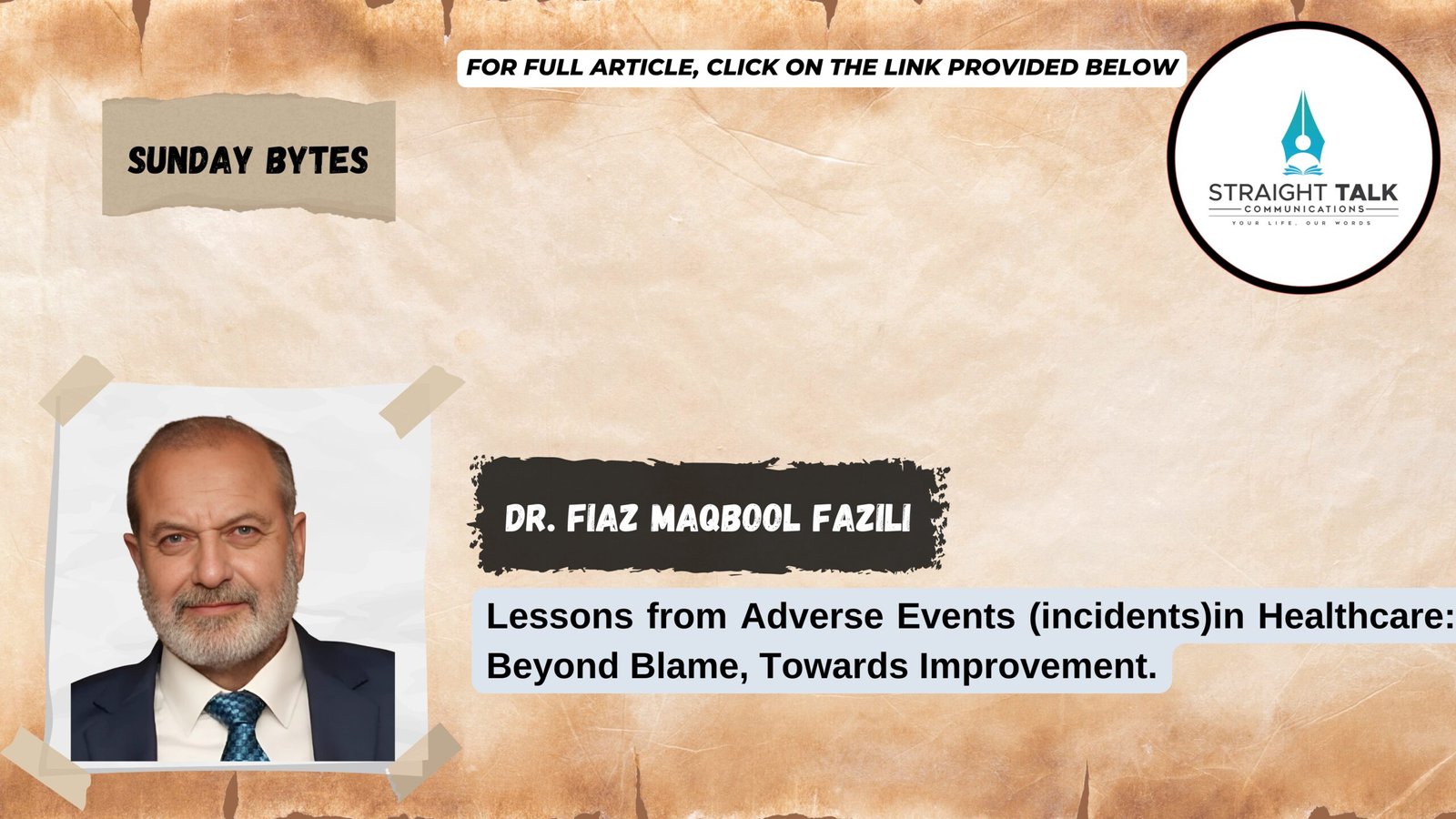Strengthening Emergency Care in Kashmir: An Urgent Call to Advance Standards and Healthcare Reforms

Lessons from Adverse Events (incidents)in Healthcare: Beyond Blame, Towards Improvement
Dr. Fiaz Maqbool Fazili
The recent unfortunate incident/s at the Emergency Department (ED) of teaching hospitals has reignited an urgent conversation about the systemic gaps in our healthcare infrastructure, particularly in emergency care delivery. As someone certified in healthcare quality and patient safety, with experience in clinical auditing and ED performance improvement, this unfortunate incident was not only saddening but also largely preventable, had appropriate Triage system and protocols been in place. Adverse events in high-stress healthcare settings, particularly in overcrowded emergency departments within constrained resources, current structure and processes of mismatch of demand and supply will be making news unless restructuring the system through necessary reforms and review of policy procedures takes place. As QPS expert such incidents are not treated as isolated occurrences but recognized as symptoms of deeper systemic and procedural gaps—offering a chance to analyze, improve, and prevent future lapses. As quality professionals, we consciously move away from the culture of name, blame, and shame. Instead, we adopt a systems-based approach: not “who is at fault,” but “what went wrong? There is scope of further improvement ” rather describe them as “opportunities to learn to do better.” Healthcare, by nature, is a continuum of improvement. Every error, near miss, sentinel event or adverse outcome must serve as a stepping stone toward safer protocols, better coordination, and more resilient systems. This is the time to move beyond reactive measures and push for comprehensive reforms. This shift is not just semantic—it is foundational to creating safer, more accountable, and learning-oriented health systems. This piece within space constraint outlines high-priority, actionable improvements for the ED and is not intended as a substitute for comprehensive strategic and operational policy reforms and long-term planning. The discussion is not about rehashing the validity of subsequent reactions—protests, strikes, or debates—which I’ve addressed elsewhere. The core issue remains every adverse event must be a catalyst for systemic improvement, not just assigning fault only. When lives are on the line, there is zero tolerance for negligence or preventable harm—provided such conclusions are reached through impartial, transparent investigations. Equally, hospital leadership must foster a supportive environment where healthcare workers can deliver their best care without undue strain or fear.”
EDs are the face of any healthcare system; they are the first point of contact during acute medical crises and often set the tone for a patient’s trust in the system. In India, especially in states like Jammu & Kashmir, tertiary care hospitals are under relentless pressure—catering to a patient load that far exceeds capacity, perfect cases of demand supply mismatch. This surge is not always proportional to the severity of illness. Many EDs in Kashmir, particularly during evening and night hours, are flooded with patients presenting with minor, non-urgent complaints such as routine blood pressure checks, sore throats, or minor headaches. These cases often bypass OPDs and queue systems, driven by convenience or lack of awareness. Unfortunately, this compromises the care of genuinely critical patients and overstretches staff, leading to potential delays, conflicts, tragic outcomes. Pending strategic planning on structural reforms including referral policy from districts to tertiary care – I have a few professional submission to make prioritising “The Pivotal Role of Strict Triage”. “The Right Patient, Right Time, Right Resource “whether you follow , the Canadian Triage and Acuity Scale (CTAS) and similar acuity-based triage systems like All India Institute of Medical Sciences Triage Protocol (ATP), strict triage of a busy emergency department can help reduce crowding and improve patient satisfaction in emergency departments (EDs)by prioritizing patients based on the severity of their condition when strictly implemented, becomes a clinical sorting mechanism—categorizing patients based on urgency and the level of intervention needed. Triage begins right at the hospital gate, not just inside the emergency department. It includes visual assessment by trained staff followed by physical evaluation. Patients are categorized into three main triage levels:
Red signifies critical cases needing immediate, life-saving intervention—such as cardiac arrest, severe trauma, respiratory failure.
Yellow indicates serious but stable patients who require attention within minutes—e.g., fractures, moderate bleeding, or fever with warning signs.
Green applies to non-urgent cases that can safely wait—like mild infections or routine check-ups. This structured triage ensures limited resources and clinical attention are directed first to the sickest patients. This approach is critical in LMIC EDs for efficient resource allocation, ensuring these go to the patients who need them most. Structured triages streamline workflow and reduce chaos and most important benefit of triage is enhanced patient satisfaction. Sick patients and their relatives experience faster, focused care. Sadly, triage in our hospital is a much-misunderstood process and /or incorrectly implemented.
EBM_evidence based best practice protocols for the top emergencies—such as chest pain, stroke, trauma, sepsis, bleeding and asthma—ensures timely, standardised, and evidence-based care, high time to see them implemented in our system. These protocols streamline triage, diagnostics, and interventions, minimizing delays and variability. Clear algorithms guide staff to deliver the right care at the right time, improving patient outcomes, reducing errors, and enhancing team coordination. Timelines for critical steps (e.g., “door-to-needle” in stroke or “golden hour” in trauma) are strictly followed, ensuring consistency across shifts and staff. Such standardization boosts patient trust, safety, and satisfaction while optimizing resource utilization in busy ED. In Kashmir’s context, making strict triage a standard operating procedure (SOP) in all teaching hospitals should be the first step toward safe emergency medicine. Triage-trained nurses and designated triage stations must be operational 24×7 to enforce categorization from the moment of arrival.
Preparing for the Unpredictabl:
“Code Blue” is an internationally recognized hospital emergency code used to alert medical staff to a patient requiring immediate resuscitation by predesignated “Code Blue” teams typically due to cardiac or respiratory arrest. It is a core pillar of hospital emergency preparedness. Shockingly, Kashmir hospitals lack institutionalized and trained Code Blue Teams. In modern healthcare systems, though many have moved ahead of Code blue with RRT rapid resuscitation teams , these teams are not just critical for clinical intervention but serve as markers of emergency readiness and interdepartmental coordination. They are activated instantly through a hospital-wide paging system and trained in synchronized resuscitation protocols (BLS/ACLS/PALS/NALS). Implementing Code Blue protocols across all teaching and district hospitals in Kashmir is non-negotiable. Training sessions, dry runs, and internal audits should be held regularly to ensure system alertness and competency.
NABH Accreditation:
A Game-Changer for Accountability and Patient-Centred Care. NABH is India’s benchmark for healthcare quality and patient safety. While private hospitals adopt it widely, most government teaching hospitals—especially in LMIC regions like Kashmir—remain unaccredited. NABH accreditation enforces standardized care, system accountability, and patient-centred practices. It introduces treatment protocols, adverse event reviews, grievance redressal, clear staff roles (job descriptions), and performance metrics for continuous improvement. Make NABH accreditation mandatory in a phased manner across Jammu& Kashmir. Begin with major tertiary centers followed by all district GMCs.In phase two, extend to district hospitals, then CHCs and PHCs.
Communication Skills Enhancement:
While infrastructure and systems matter, human interaction is often the deciding factor in volatile environments like an ED. Poor communication or due to language barrier and a misperceived notion of lack of empathy by doctors—especially non-local or trainee medicos—can easily escalate tensions with already distressed patients or their restless attendants. The doctor-patient relationship relies heavily on communication, trust, and compassion for effective healthcare. Physicians must exhibit empathy(ikhlaqiyat) and strong communication skills to ensure patient satisfaction. Compassionate care is not only ethically and spiritually significant—”Those who show mercy will be shown mercy by the Most Merciful”—but also enhances therapeutic outcomes by fostering trust and holistic treatment. However, not all doctors naturally possess these skills, highlighting the need for formal training in empathetic communication to improve patient interactions and overall care quality.
Key takeaways:
Rebuild through reform, not reaction. The recent incidents must be remembered not as a stray altercation between individual doctor or patient attendant. It is time to stop depending on ad-hoc, reactive firefighting and instead build resilient, responsive systems. The roadmap ahead is clear, I tried to cover top priorities only the details are beyond scope of this piece. Drawing from personal and professional experience, the need for continuous improvement is stressed—suggesting more doctors (especially seniors), BLS/ALS/PALS/ACLS /NALS certification for ED staff, and enhanced nursing support. CEOs, Directors, Principals, Medical Superintendents or Deputy ,and CMOs must routinely conduct Gemba Walks—a Japanese management practice meaning “go to the real place of contact”—especially during night shifts in Emergency Departments, to directly observe ground realities, identify gaps, interact with staff, and ensure accountability in critical care delivery under real-time conditions.
Let this be our turning point. We owe it to our patients, to our healthcare workers, and to the trust that binds them together. While it’s essential to hold authorities accountable for maintaining hospital standards, visitors, patients, and patient attendants also have a critical role to play. By avoiding unnecessary overcrowding of emergency departments, maintaining hygiene, using facilities responsibly, and adhering to infection control practices, we can contribute to a better, more efficient healthcare system. Responsible behaviour not only helps the hospital function smoothly but also ensures that every patient receives the best possible care.
For a long time, doctors as a community have been unfairly portrayed in a negative light, leading to deep-rooted public distrust in the medical profession, sadly ignoring bad apples are in every profession and essentially, they don’t represent good majority. Unfortunately, the accusations of bad narratives have permeated society to the extent that many now view all medical professionals with suspicion. Trust in character is cumulative and earned over time as when you keep your professional ethics, morality, honor intentions, and meet agreed/implied expectations. Patients and their attendants often enter hospitals with preconceived expectations ,hopes and notions, with bad publicity even assuming the worst, rather than approaching healthcare providers with trust and respect.
My humble request to my friends in the media—many of whom I spend more time with than even my medical colleagues—is to avoid settling for one-sided narratives when reporting adverse events in healthcare. Please strive to present the full picture, including the perspective of healthcare professionals. Please project a good Samaritan-empathetic picture of doctors too. Likewise, I appeal to civil society groups who regularly hold seminars on ethics and morality may also advocate for broader ethical conduct in society at large, which is witnessing a serious moral decline. The whole community needs moral training. Disturbances of the previous decades has made us weak on patience, be it a _ doctor, a patient, a teacher, a parent, shopkeeper or a customer. It is not one at fault. System building is collective responsibility.
(The author is a practicing surgeon and certified expert in healthcare quality improvement has worked extensively as a healthcare auditor and has engaged with both national and International bodies to enhance health systems in resource-constrained environments.)







